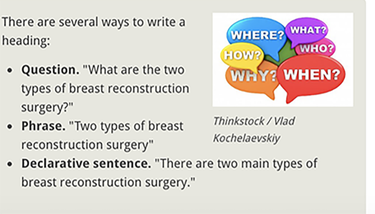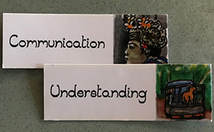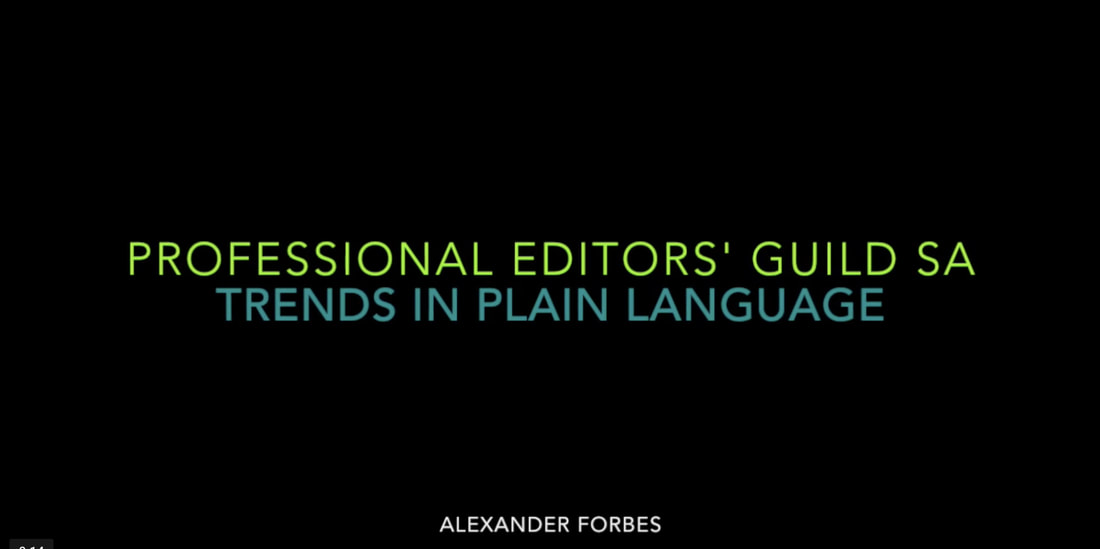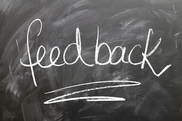|
Plain language offers benefits to writers, readers and organizations. With time and cost savings available for staff and happier clients, it makes sense to integrate it. We have great demands on our time, our minds and our budgets. Plain language is a great problem solver. Put plain language on your calendar for a clearer year ahead. What problems can plain language solve? If your clients, staff or volunteers aren't understanding your messages, then you have to spend time repeating instructions, clarifying procedures and answering questions. All these are unnecessary, if your original message meets these plain language guidelines: 1. is easy to understand 2. can be quickly navigated to find what is wanted 3. is clear so it can be effectively acted on. Ask these of all your communications and see where you stand. Ask your readers for feedback. Why integrate plain language? There are so many benefits to plain language. Plain language is a simple process that when integrated into your writing tasks brings these benefits: 1. 50% less time spent writing 2. 40-60% less time spent reviewing 3. 50% fewer drafts needed When you compare that to the reduced costs associated with producing information, it speaks savings. Check out our first blog of the year "Integrating clear visuals" for a closer look at how to be creative and clear at the same time. How do I spread the word? Plain language is a process and is best achieved with a team. You need to persuade or have a trainer or consultant sell your management team on the benefits of plain language. When the organization is ready to make the commitment, then consider a pilot project. Bringing in a trainer is helpful in developing staff skills and knowledge. It's also a great team builder. Integrate plain language practices into your style guide. Plain language is for everyone: management, staff and clients. It works for internal and external messages. Research shows no one likes to or wants to have to read information they can't easily understand. Take the lead. Choose this year to introduce, expand or celebrate your plain language program.
0 Comments
Many organizations are making the commitment to plain language. This means all staff need the tools to make it happen. One route to success is to integrate plain language guidelines into your existing style guide or build an organizational style guide around one. Supporting this with training ensures staff have the skills and knowledge to put it into practice. Style documents explainedStyle Sheets
Style Guides
Style Manuals
So, how does plain language fit in? Plain language stylePlain language is a communication process that covers:
These foundations are integrated into style guides ensuring plain language is an integral part of your communication style. I have found supporting plain language style guide integration with training sessions is a great staff-strengthening and team building investment. AuthorsKate Harrison Whiteside, PlainLanguageAcademy.com and Communication trends for 2019 strongly focus on visuals and clear communication. These are both key components of the plain language process. Committing to integrating clear visuals with plain text will help you succeed in meeting these new directions and your clients’ needs. Whether it’s headings, graphics or videos, 2019 is the year to use visuals to get your message across. Put people first HR Trend Institutecites 2019 as the year for more listening and less messaging; more talking to each other; improved personalization; increased ability to act quickly; and, more visuals, less text. The focus is on connecting better with people and plain language puts people first. Help readers skim Skimming is how today’s readers absorb information—in print and online. Previously, it was primarily the style of online readers only. Check that your information provides visual cues to help readers find and re-find information easily and quickly, regardless of the media. Make this part of your 2019 plain language checklist.  Source: www.nih.gov/institutes-nih Source: www.nih.gov/institutes-nih Integrate clear visuals Plain language writing and editing are well-established processes for helping clients understand. However, ensuring visuals, design and layout contribute to clear information—in print and online—can be challenging. Michelle Boulton, Clear Communication Strategist at 3cpublications.ca, specializes in this field and shares advice. In documents, visuals are often the elements that draw a reader in and make information easy to understand. Most people remember only 10% of what they hear and 30% of what they read, but about 80% of what they see. So, the combined use of visuals and text is said to be six times more effective than the use of text-based communication alone. Visuals can express ideas and convey information in ways that words alone cannot. They communicate by:
Get a clear picture of your audience’s needs. Use the power of visuals and text working together to send out clearer messages. Make 2019 your year to put people first. Thanks Michelle. 3cpublications.ca Visit PlainLanguageAcademy.com Calendar to register for upcoming courses. Check out Clear Design Practices with Flora Gordon. Plain language reaches across all languages, all sectors and all tasks. But, in this Forbes magazine article by Kate Harrison (not me), the link between virtual communication and clear emotions points out another dimension of plain language.
Virtual communication's emotional side effects Kate’s article is a review of Nick Morgan’s new book, Can You Hear Me?: How to Connect with People in a Virtual World looking at the conflict between our volume of virtual communication and increase in feelings of isolation and even depression. This less than satisfactory communication does not meet the plain language focus on audience awareness. So, what’s the cure? Know your audience Communicating clearly involves body language, not just words and pictures. As conference calls, webinars and smartphone video calls increase in popularity, we need to increase our audience awareness, a key part of the plain language process. We need to keep our emotional language clear. We need to integrate empathy. It’s all about humanizing the technology we rely on. Being an empathetic communicator Author Nick Morgan recommends storytelling as a great cure for this problem. exTalks article Incredible Tips for Effective Online Communication recommends using personas that communicate empathy and competence. In their zendesk relate post, Leaders, use empathetic language when talking to remote workers, Sarah Stealey and Rebecca Huval examine how to manage technology and talking virtually. Empathy Business CEO Belinda Parmar says empathy is what today’s leaders and organizations need to survive. The Centre for Plain Language identified this issue some time ago in their Empathy: The Forgotten Element in Successful Plain Language Communicationarticle by Deborah S. Bosley. She reminds us of the plain language focus on understanding and being understood. Put empathy on your plain language checklist So, the next time you are communicating via technology and want to achieve clear or plain language, check that empathy is on your list. Take the PlainLanguageAcademy.com Audience Awareness course. Starts Feb 1 and May 1. Sign up now. The link between clear communication and better organizational results has been made by Kimberly A. Whitler in a recent Forbes magazine article How Workplace Simplicity Impacts Company Results. But she's not alone in providing proof. Clarity connectsWhitler explains how a confusing presentation on a complex sales strategy lost employees’ attention and commitment. A year later, a new sales leader, a new approach: a simple presentation that used clear language, audience-friendly concepts and the sheer simplicity resulted in sector growth. Siegel+Gale support power of simplicityLast year Siegel+Gale did a study on how simple workplaces improve employee engagement and commitment. They found that organizations who commit to clear communication tend to be simpler from top to bottom, and show increased workplace effectiveness and employee commitment. Their research found 95% of employees were more likely to trust leaders in a clear culture. Plain language will be a key part of this environment. Plain language for the peopleThe province of British Columbia supports plain language in government. They ask Why Should I Care About Plain Language? on their website. The answer: it reduces time, misunderstandings, client calls and increases accessibility and confidence in content.
The bottom of line, plain language can positively affect profits, people and processes. Plain language has become a global movement. Writers, editors, designers, testers, trainers, leaders are all connecting, sharing and benefitting. I presented on Trends in Plain Language to the Editors Canada 2018 Conference and the SA Professional Editors' Guild workshop. Here's the video highlights courtesy of SA PEG group.
Watch on our Plain Language Academy Youtube Channel Presentations make for a competitive challenge. We prepare them, watch them and try to remember them. So, what makes one stand out? The use of simple, strong, clear, relatable language and images that connect with audiences. All these are key components of plain language. Here are ideas on how to increase the use of clear visuals and the impact of your next presentation. Integrating plain language guidelinesMarketingmag.com.au points out the weaknesses of presentations junky with charts, jargon and top heavy with text. Plain language guidelines can solve all these challenges. If you commit to clear language, concise messages and simple images that support your ideas, people will relate better and remember longer. Integrate plain language guidelines for your content and visuals to make your presentation memorable. Inspiring audiencesPresentation software is no longer exclusive. And, audiences come with high expectations. How can you meet them? In her article, ‘Choosing the right visuals’, Emma Bannister quotes research showing that 90% of what our brain processes is visual. A picture really can be worth a thousand words. The clear communication rules of simplicity apply here too. Rule 1: make sure the visual supports the text. Rule 2: design and present visuals that are audience-friendly. Rule 3: use real settings, people and locations whenever you can. Always ask, and preferably to a test audience, what viewers think of the content, the visuals, the presentation. Put people first and you’ll experience presentation power. After all, it is them we have to inspire. Impressions that lastPresenters can use clear design and presentation guidelines to enhance engagement. Gov.uk demonstrates how they committed to using simple slides to achieve memorable presentations. Choose a presentation style that supports clear information and visuals, and stick to it. Consistency in visuals is another way to have an impact.
Making an outstanding presentation relies on clarity, simplicity and strong visual impact. Set plain language guidelines, involve a test audience for feedback and be prepared to make changes to meet their needs. If you can confidently say you kept it simple, clear and really connected with visuals, you are heading for presentation success with some help from plain language guidelines. Want to learn more, take a PlainLanguageAcademy.com course. Editors Canada Conference 2018, May 25-27, Saskatoon: Plain Language Stream  When Frances McDormand said the words “inclusion rider”, during her Academy Awards Best Actress Oscar acceptance speech, it meant so much more than the two words themselves. Plain language is most often practiced around the written word, presented on paper or online. But, when you mix in speaker, setting, audience and context, words can take on a much more dynamic meaning. Defining "inclusion rider" Not everyone would have a clear understanding of the legal implications of the words “inclusion rider”, but would use their familiarity with each term individually. McDormand herself is reported to have only recently become familiar with this contract option. But, in their legal sense, in the acting profession, here is how Wikipedia defines them: “An inclusion rider or equity rider is a provision added to a contract of an actor to ensure that casting and production staff are more representative and meet a certain level of diversity…” When a production company agrees to this rider, but doesn’t meet it, consequences can result. So, you take two plain words, mix in a legal connotation, and their meaning and impact can greatly change. Plain speaking and presentation impacts Inclusion researcher Dr. Stacy Smith presented data outlining the film industry’s inequalities in a TED Talk, highlighting the point that A-listers (top actors) can lead change with inclusion riders. That’s one group McDormand was addressing in her Oscar speech. But, the impact of those two words were super-enhanced by three environmental conditions because McDormand had:
Combine plain language and clear design On paper and online, we often don’t have that kind of influence. So, plain language is all the more important to get our messages across with the intended meaning, to the intended audience, generating the intended outcome. The next time you write content for a document, website or speech, consider the impact using plain language can have, especially if it is supported by clear visuals. The combined effect of plain language and clear design can be memorable. That's what we want in our communication. PlainLanguageAcademy.com 2018 course line-up. Register now. Clear Design and Plain Language Basics begin April 1. Advanced: Editing for Plainer Legal Writing begins April 10. Plain language still evokes many questions. What is it all about? How does it work? What benefits are there? You can simply answer the questions. Or, you can ask for some time to do a training exercise to bridge the knowledge gap. This can be anything from a short team training exercise, a learning-at-lunch program, presentation to key leaders or an event keynote presentation. Of course, you can run a workshop. So, what are some of your options? Draw Personas Audience awareness plays a huge part in plain language. You need a detailed picture of your audience for your team to create, commit to and use throughout the project. Personas involve drawing pictures or creating profiles of your audience using research on their lifestyle, cultural, social, professional and personal activities and values. Usability.gov has an excellent description of how to do personas. I find it a fun activity to open a training activity or for team building. Develop content for a style guide Integrating plain language guidelines into an existing style guide or creating a stand-alone guide is a great investment with a long shelf life. Focus on jargon and simple words that can replace your organizations in-house language. Everyone appreciates a writing resource. They save time, create shared techniques, enhance peoples’ skills. Integrating it into an existing style guide increases its value and can be a great stepping stone to a learning event. Create a plain language checklist Plain language checklists are available online. Most are very generic. Get your communications and plain language project teams together to brainstorm a checklist specific to your task, your audience or organization. This increases colleagues’ understanding of, skills for and commit to plain language. Carry out an audit Without embarrassing or intimidating anyone, carry out a plain language audit. Gather a team and collect a variety of documents or information sources and measure against selected plain language guidelines. Share the findings and as a group come up with recommendations for future information. Apply for an award Awards offer several opportunities for learning and committing to plain language. It helps others see what the standards are in the profession. If you are recognized, you have motivation to move forward with your plans. PLAIN ( Plain Language Association InterNational) offers members opportunities to be recognized at its conferences. Other organizations offer annual awards. Just participating can be rewarding. Integrate training into your plain language projects, style guides, training plans. Reap the benefits.
 Plain language is customer service. Photo courtesy of BigStock. Plain language is customer service. Photo courtesy of BigStock. As I holidayed this summer, in Canada and in the US, I found myself comparing levels of and styles of customer service. Experiencing a lack of clarity in instructions, directions and information, it reminded me that plain language truly is a form of customer service excellence. Any business can gain an advantage by using plain language. In preparing for my presentation The Solution to Persuading Plain Language Sceptics—Training for the PLAIN 2017 Conference: Improving Client Relationships, I became even more convinced we need to really persuade clients—internal and external—to integrate plain language with customer relations initiatives. What benefits does plain language provide? Unhappy clients can mean a loss of business and negative publicity. It can affect staff morale, productivity and commitment. No one wants these. Incorporating plain language and supporting it with training offers huge benefits for your staff and clients:
What are my plain language training needs? The best way to plan your plain language training is to begin with a thorough audit of what communication training has been or is being delivered. Identify key customer relations problems—existing or potential. Then assess who needs which skills or knowledge in clear communication. Once all these are agreed, the plan can take shape. Plain language training can be stand-alone, integrated or connected to a specific project. What should we focus on?
What results should we look for? Integrate plain language training or consulting into every customer service initiative. Ensure staff can effectively connect with clients using clear communication for problem solving and promotions. Look for and measure the improvements:
Check the PlainLanguageAcademy.com Calendar for courses that can help. We offer three options for Course 6: Plain Language Project, including coaching and consulting combinations. |
Let's stay connected.Subscribe to our blog for Plain Language Academy news, tips and updates. Categories
All
Archives
September 2023
|
Choose your Academy. Choose your courses. We are here to work with you.
www.facebook.com/plainlanguageacademy Twitter #plainlanguageacademy




 RSS Feed
RSS Feed